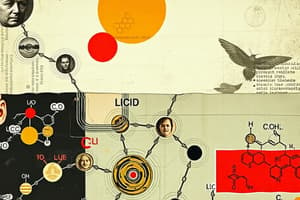Podcast
Questions and Answers
Which of the following describes an exergonic reaction?
Which of the following describes an exergonic reaction?
- Releases energy and is spontaneous. (correct)
- Requires energy input and is non-spontaneous.
- Releases energy and is non-spontaneous.
- Requires energy input and is spontaneous.
Anabolic reactions are considered favorable and exergonic.
Anabolic reactions are considered favorable and exergonic.
False (B)
What is the primary role of ATP in the cell?
What is the primary role of ATP in the cell?
ATP acts as the cell's energy shuttle, mediating most of the energy coupling.
The region on an enzyme where the substrate binds is called the ______.
The region on an enzyme where the substrate binds is called the ______.
Match the following terms related to reactions with their descriptions:
Match the following terms related to reactions with their descriptions:
What happens when the terminal phosphate bond of ATP is broken?
What happens when the terminal phosphate bond of ATP is broken?
Enzymes increase the change in free energy (∆G) of a reaction.
Enzymes increase the change in free energy (∆G) of a reaction.
What is activation energy?
What is activation energy?
A _______ is a catalytic protein that speeds up a reaction.
A _______ is a catalytic protein that speeds up a reaction.
What is the effect of an enzyme on the activation energy barrier?
What is the effect of an enzyme on the activation energy barrier?
Which of the following BEST describes metabolism?
Which of the following BEST describes metabolism?
Catabolic pathways consume energy to build complex molecules.
Catabolic pathways consume energy to build complex molecules.
What type of reaction is generally associated with catabolic pathways?
What type of reaction is generally associated with catabolic pathways?
Anabolic reactions are generally considered to be ______ reactions.
Anabolic reactions are generally considered to be ______ reactions.
Match the following terms with their correct description:
Match the following terms with their correct description:
What does a negative change in Gibbs free energy (∆G < 0) indicate about a reaction?
What does a negative change in Gibbs free energy (∆G < 0) indicate about a reaction?
A reaction with a positive change in Gibbs free energy (∆G > 0) is considered spontaneous.
A reaction with a positive change in Gibbs free energy (∆G > 0) is considered spontaneous.
If the change in Gibbs free energy (∆G) is equal to zero what state is the system in?
If the change in Gibbs free energy (∆G) is equal to zero what state is the system in?
Cellular respiration is an example of a ______ pathway.
Cellular respiration is an example of a ______ pathway.
What is the common difference between anabolic and catabolic reactions?
What is the common difference between anabolic and catabolic reactions?
What type of interaction primarily holds a substrate to an enzyme's active site?
What type of interaction primarily holds a substrate to an enzyme's active site?
An apoenzyme is a fully functional enzyme without any cofactors.
An apoenzyme is a fully functional enzyme without any cofactors.
What is the term for an organic cofactor?
What is the term for an organic cofactor?
Reaction rates level off at high substrate concentrations because all available active sites are ______ with substrate molecules.
Reaction rates level off at high substrate concentrations because all available active sites are ______ with substrate molecules.
Match the following terms with their descriptions:
Match the following terms with their descriptions:
Which of the following would be considered an inorganic cofactor?
Which of the following would be considered an inorganic cofactor?
Increasing the temperature beyond the optimal temperature for an enzyme will increase the rate of reaction.
Increasing the temperature beyond the optimal temperature for an enzyme will increase the rate of reaction.
What process is responsible for an enzyme losing its function due to excessive pH or temperature?
What process is responsible for an enzyme losing its function due to excessive pH or temperature?
In feedback inhibition, the ______ of a metabolic pathway shuts down the pathway.
In feedback inhibition, the ______ of a metabolic pathway shuts down the pathway.
How can the effect of a competitive inhibitor be overcome?
How can the effect of a competitive inhibitor be overcome?
Flashcards
Metabolism
Metabolism
The sum of all chemical reactions that occur within an organism.
Metabolic Pathway
Metabolic Pathway
A series of chemical reactions that convert a specific starting molecule into a final product.
Catabolic Pathways
Catabolic Pathways
Reactions that break down complex molecules into simpler ones, releasing energy.
Anabolic Pathways
Anabolic Pathways
Signup and view all the flashcards
Gibbs Free Energy (G)
Gibbs Free Energy (G)
Signup and view all the flashcards
Change in Gibbs Free Energy (∆G)
Change in Gibbs Free Energy (∆G)
Signup and view all the flashcards
Exergonic Reaction
Exergonic Reaction
Signup and view all the flashcards
Endergonic Reaction
Endergonic Reaction
Signup and view all the flashcards
Spontaneous Reaction
Spontaneous Reaction
Signup and view all the flashcards
Non-spontaneous Reaction
Non-spontaneous Reaction
Signup and view all the flashcards
Enzyme-substrate complex
Enzyme-substrate complex
Signup and view all the flashcards
Active site
Active site
Signup and view all the flashcards
Catalyst
Catalyst
Signup and view all the flashcards
Activation energy
Activation energy
Signup and view all the flashcards
Transition state
Transition state
Signup and view all the flashcards
ATP hydrolysis
ATP hydrolysis
Signup and view all the flashcards
ATP
ATP
Signup and view all the flashcards
Energy coupling
Energy coupling
Signup and view all the flashcards
How active sites lower activation energy?
How active sites lower activation energy?
Signup and view all the flashcards
Co-factor
Co-factor
Signup and view all the flashcards
Co-enzyme
Co-enzyme
Signup and view all the flashcards
Apoenzyme
Apoenzyme
Signup and view all the flashcards
Holoenzyme
Holoenzyme
Signup and view all the flashcards
Optimal Temperature
Optimal Temperature
Signup and view all the flashcards
Optimal pH
Optimal pH
Signup and view all the flashcards
Competitive Inhibitor
Competitive Inhibitor
Signup and view all the flashcards
Study Notes
Metabolism & Enzymes
- Metabolism is the sum of all chemical reactions in an organism.
- Metabolism is an emergent property of life, arising from interactions between molecules in the cell.
- A metabolic pathway is a series of chemical reactions, beginning with a specific molecule (the starting molecule) and ending with a product.
- Each step in a metabolic pathway is catalyzed by a specific enzyme.
Catabolic Pathways
- Catabolic pathways release energy by breaking down complex molecules into simpler compounds.
- Catabolic reactions are generally hydrolysis reactions (reactions that use water to break down chemical bonds).
- Cellular respiration (the breakdown of glucose in the presence of oxygen) is an example of a catabolic reaction.
Anabolic Pathways
- Anabolic pathways consume energy to build complex molecules from simpler ones.
- Anabolic reactions are generally dehydration synthesis reactions (reactions that release water to form bonds).
- The synthesis of protein from amino acids is an example of an anabolic reaction.
Concept B: Free Energy Change
- Gibbs free energy (G) measures usable energy in a system.
- The change in Gibbs free energy (ΔG) during a reaction indicates whether the reaction is spontaneous (occurs without an input of energy) or non-spontaneous (requires an input of energy).
- ΔG = Gproducts - Greactants
- Negative ΔG indicates a spontaneous (exergonic) reaction.
- Positive ΔG indicates a non-spontaneous (endergonic) reaction.
- ΔG = 0 indicates equilibrium.
Free Energy and Metabolism
- An exergonic reaction releases free energy.
- An endergonic reaction absorbs free energy.
Concept C: ATP
- ATP (adenosine triphosphate) is the cell's energy shuttle.
- ATP is composed of ribose (a sugar), adenine (a nitrogenous base), and three phosphate groups.
- The bonds between phosphate groups in ATP can be broken by hydrolysis, releasing energy.
- This energy can be used by organisms for various purposes including active transport and muscle contraction.
Concept D: Enzymes
- Most proteins are enzymes.
- Enzymes act as catalysts, speeding up chemical reactions without being consumed.
- Enzymes are catalytic proteins.
- An enzyme-catalyzed reaction lowers activation energy (the initial energy needed to start the reaction).
- Hydrolysis of sucrose by sucrase is an example of an enzyme-catalyzed reaction.
Activation Energy
- Activation energy (Ea) is the initial energy needed for a reaction to occur.
- The transition state is a high-energy unstable state that occurs when molecules must be bent/contorted to break bonds.
- Enzymes facilitate reactions by lowering the activation energy.
Enzyme Saturation
- The speed of enzyme-catalyzed reactions increases linearly at low substrate concentrations when there are more active sites on the enzyme available to bind the substrate.
- Once the available active sites on the enzymes have been filled with the substrate, the speed of enzyme-catalyzed reactions slows down and plateaus.
- Enzymes reach their maximum speed when all active sites are occupied.
Components of an Enzyme
- Apoenzyme: Protein portion of an enzyme.
- Cofactor: Non-protein component, can be inorganic (metals) or organic (coenzyme).
- Coenzymes are organic co-factors.
- Holoenzyme: Complete active enzyme (apoenzyme + cofactor).
Concept E: Local Conditions Influencing Enzyme Activity
- Enzyme activity can be affected by environmental factors (temperature, pH) and specific chemicals (inhibitors, activators).
Effects of Temperature
- Each enzyme has an optimal temperature where activity is highest.
- Increasing temperature increases the kinetic energy of molecules, leading to higher reaction rates initially but exceeding the peak point, enzyme activity suddenly decreases and plateaus due to denaturation (breaking of bonds in the tertiary enzyme structure)
Effects of pH
- Each enzyme has an optimal pH where activity is highest.
- pH affects the ionic and hydrogen bonds that maintain the enzyme's structure.
- Deviations from the optimal pH lead to denaturation and decreased activity.
Enzyme Inhibitors
- Competitive Inhibitors: bind to the active site, competing with the substrate. Effectiveness of these inhibitors can be overcome by adding more substrate.
- Non-competitive Inhibitors: bind to an allosteric site, causing a change in the enzyme's shape that reduces its effectiveness. Adding more substrate does not reverse the effectiveness of these inhibitors.
Feedback Inhibition
- Feedback inhibition is a metabolic control mechanism where the end product of a metabolic pathway shuts down the pathway.
- The end product usually binds to an allosteric site on an enzyme early in the pathway, reducing its activity and preventing further production of the product. This prevents the cell from wasting resources.
Studying That Suits You
Use AI to generate personalized quizzes and flashcards to suit your learning preferences.




